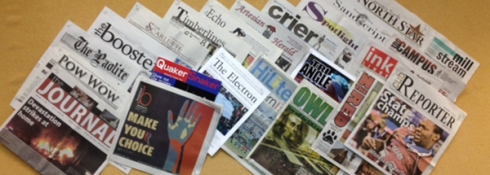 There are at least 10 good reasons why some newspaper staffs shine a bit brighter in IHSPA’s 2014 Hoosier Star Critique and Competition. The good news is that none of these characteristics have anything to do with big budgets or special resources. Simply, good news staffs approach and frame content differently. Let’s break it down. (Note: Hoosier Star winners will be announced at the convention in October. The samples used in this blog were drawn from 21 newspaper finalists.)
There are at least 10 good reasons why some newspaper staffs shine a bit brighter in IHSPA’s 2014 Hoosier Star Critique and Competition. The good news is that none of these characteristics have anything to do with big budgets or special resources. Simply, good news staffs approach and frame content differently. Let’s break it down. (Note: Hoosier Star winners will be announced at the convention in October. The samples used in this blog were drawn from 21 newspaper finalists.)
_________________________________
• Content With A “You” Turn — Content is at the heart of any effective student publication but Hoosier Star newspapers place a strong emphasis on local news coverage often followed with related editorials. Unfortunately, many publications settle for general feature and “entertainment” topics often at the expense of news from classrooms, clubs, sports or other academic/curriculum issues at home. Both the Cub Reporter (Lawrence Central) and North Star (Lawrence North) allocate 25-30 percent of their space to school news and to the people “behind” the news.
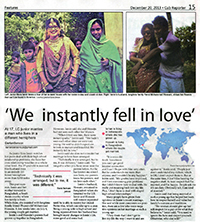 > The Cub Reporter (click left) mixes news and student/faculty-driven features well when it profiled a student who, at 17, traveled to Bangladesh to marry a man she hadn’t seen in 14 years. The staff also feature a science teacher who made it to the base camp of Mt. Everest and also pose good questions for the new superintendent of Lawrence schools. This is good news reporting augmented by “behind the scenes” local feature writing.
> The Cub Reporter (click left) mixes news and student/faculty-driven features well when it profiled a student who, at 17, traveled to Bangladesh to marry a man she hadn’t seen in 14 years. The staff also feature a science teacher who made it to the base camp of Mt. Everest and also pose good questions for the new superintendent of Lawrence schools. This is good news reporting augmented by “behind the scenes” local feature writing.
> The North Star staff provides depth coverage of the school’s “Hispanic Heritage” at Lawrence North. The North Star staff also capture an interesting view of LNHS after hours through a photo essay.
• Layering — Layering a story is nothing more than finding visual ways to support the text of the story. Layering is significant when the visual aspects contribute uniquely to the story either by localizing the news angle or adding personal context. No staff does this better than the Carmel HiLite staff who seems to ask of every story: “Why should readers care?” Editors then go about finding ways to make readers care.
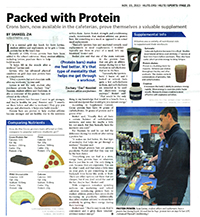 > A story (click left) about the protein bar, Crons, offered in the Carmel cafeteria is told through sophomore Scott Levine as he passes through the lunch line. Editors arrange for a photo of Levine making his way through the line and a caption details why Levine values the Crons bar. A nearby graphic compares the nutritional value of Crons with other food items like pizza or a calzone. The story — the blueprint for the page — is descriptive and the visual layers add meaning to the story. As a reader, the layering allows me to browse the many points of entry and helped me to care.
> A story (click left) about the protein bar, Crons, offered in the Carmel cafeteria is told through sophomore Scott Levine as he passes through the lunch line. Editors arrange for a photo of Levine making his way through the line and a caption details why Levine values the Crons bar. A nearby graphic compares the nutritional value of Crons with other food items like pizza or a calzone. The story — the blueprint for the page — is descriptive and the visual layers add meaning to the story. As a reader, the layering allows me to browse the many points of entry and helped me to care.
 >Student lug around heavy backpacks all the time. But perceptive Munster Crier editors (click left) did their research about how this extra weight — sometimes 30 pounds worth — affects a student’s health. Titled “Backbreaking,” Crier designers layer the story with a descriptive lead and follow with a creative “reality check” info box along with a survey. The layering should make it easy for students to find various “points of entry” into the story design.
>Student lug around heavy backpacks all the time. But perceptive Munster Crier editors (click left) did their research about how this extra weight — sometimes 30 pounds worth — affects a student’s health. Titled “Backbreaking,” Crier designers layer the story with a descriptive lead and follow with a creative “reality check” info box along with a survey. The layering should make it easy for students to find various “points of entry” into the story design.
• Eye For Personal Context — Whether in a news, feature, entertainment, opinion or editorial piece, personal context matters. The best staffs seek the student angle first; they tell stories through people closest to the story, and they interview with an eye on good story telling techniques.
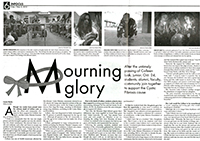 > When a popular student died of cystic fibrosis at Munster High School, (click left) a Crier reporter interview six close friends of the girl along with the girl’s mother. Aptly titled “Mourning Glory,” timely photos show the Munster student body’s emotional response to the death and an info-graphic reflects ways to “give back.” This is a great story package that hinges first on one student before transitioning to a larger story.
> When a popular student died of cystic fibrosis at Munster High School, (click left) a Crier reporter interview six close friends of the girl along with the girl’s mother. Aptly titled “Mourning Glory,” timely photos show the Munster student body’s emotional response to the death and an info-graphic reflects ways to “give back.” This is a great story package that hinges first on one student before transitioning to a larger story.
> The Paolite staff (Paoli High School) does a nice job with their story about Hunter Rohl and his battle with leukemia. But sourcing for this story did not just rest with Hunter. Paolite editors include a sidebar story with teacher Pam Minton who plans to “buzz cut” her hair as a way to raise money for cancer research. Moreover, on Page 8 of this same issue, editors focus on a local Relay For Life event that feature key sources who raise funds for cancer research. Good planning.
• Eye For The Anecdote — Effective story telling often comprises a series of “little stories” told within the larger one. Reporters who are sensitive to the anecdote encourage sources to tell their own stories. The anecdote often is the best way to frame a lead before transitioning into the larger story. Roy Peter Clark, a writing coach with the Pointer Institute for Media Studies, calls the well-placed anecdote a “gold coin” in the story. These “moments” often surprise and delight readers which helps sustain the story’s momentum. (See Clark’s “50 Writing Tools” here.)
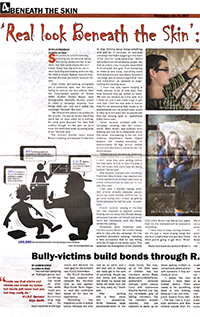 > The Huntington North Campus wrote a story about bullying, (click left) a popular topic in 2014. But instead of using anonymous sources or relying mostly on material from the Internet, Campus reporters find students who have experienced bullying and allow them to tell their stories in their own way.
> The Huntington North Campus wrote a story about bullying, (click left) a popular topic in 2014. But instead of using anonymous sources or relying mostly on material from the Internet, Campus reporters find students who have experienced bullying and allow them to tell their stories in their own way.
> When a Huntington North student totaled her car on the way to school on a foggy morning, a Campus reporter recreates the situation with an effective descriptive lead followed by a timely staff editorial. The key here is the focus on the single student anecdote first before transitioning to additional coverage. When using a Page 1 story as the basis for an editorial in the same issue, I’d like to see more staffs use a tagline in the news story that says, (See related editorial, Page __). Make the relationship between a news story and editorial clear.
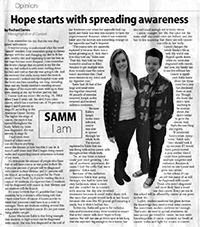 >Rachael Samm is an excellent column writer for the Southport Journal because she’s a good reporter first. Her column about cancer was heartfelt because of the death of her own mother to this disease. In her “Samm I Am” column, Rachael uses her own experience to segue into the larger focus of the column about the courageous battle of a fellow student who fought the same kind of colon cancer that killed her mother. A cutout image of both Samm and her friend, Mackenzie Eakle, creates a very effective point of entry into this informative opinion piece.
>Rachael Samm is an excellent column writer for the Southport Journal because she’s a good reporter first. Her column about cancer was heartfelt because of the death of her own mother to this disease. In her “Samm I Am” column, Rachael uses her own experience to segue into the larger focus of the column about the courageous battle of a fellow student who fought the same kind of colon cancer that killed her mother. A cutout image of both Samm and her friend, Mackenzie Eakle, creates a very effective point of entry into this informative opinion piece.
>The Munster High School Crier staff use the anecdotal lead effectively in its excellent story about school theft titled, “Without A Trace.” The package includes an effective cutout along with timely into-graphics and a well-written headline/summary combination. The reporter lets theft victims tell their own stories.
• Content That Drives Design — Hoosier Star publications have impact because they use every aspect of the story design to keep readers focused on what’s important. Good content design is more than the physical aspects of dominance, balance and contrast. It’s about following a coherent plan that begins with the written lead and follows through to every visual aspect of the design. Design driven by content means there is communication among editors that gives the story a sense of focus and continuity.
 > The sports editor of the Crown Point Inklings begins his sports story with a key moment about a girls basketball star (a narrative approach): It’s 6 p.m. on a Tuesday night when Hannah Albrecht realizes she’s good enough to create her own legacy. The idea of a “legacy” guides the headline and caption writer as well. The headline proclaims, “EX-SPIKE-TATIONS,” and the story’s focus dictates the architecture of the design right down to the cutline (which readers see second after the photo cutouts).
> The sports editor of the Crown Point Inklings begins his sports story with a key moment about a girls basketball star (a narrative approach): It’s 6 p.m. on a Tuesday night when Hannah Albrecht realizes she’s good enough to create her own legacy. The idea of a “legacy” guides the headline and caption writer as well. The headline proclaims, “EX-SPIKE-TATIONS,” and the story’s focus dictates the architecture of the design right down to the cutline (which readers see second after the photo cutouts).
> At nearby Munster H.S., Crier staffers recognize the contributions of athletic trainers. Using the story angle of “More than Water Girls,” editors and writers create a very readable page design that keeps readers glued to personal stories which in turn informs the story design.
> Given the sheer emotional appeal of the four-column photo of Huntington North H.S. junior Paige Vanover recovering from brain surgery, I can’t imagine readers at Huntington North High School ignoring this story. Note the powerful content of the photo which in turn drives the headline, cutline and story here.
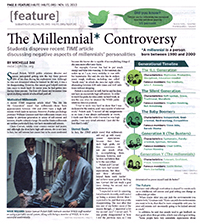 > Carmel HiLite editors seem a bit peeved at the suggestion in a TIME magazine article that millennials — those born between 1980 and 2000 — might be a bit lazy. Told through the experiences of senior Samual Pickett, reporter Michelle Dai details the hard-working nature of Carmel millennials. Designers follow the story’s lead with a clarifying timeline and layer other graphics that stay true to Dai’s story approach. Again, content and story angle come first. And story designers wisely expand on the story angle.
> Carmel HiLite editors seem a bit peeved at the suggestion in a TIME magazine article that millennials — those born between 1980 and 2000 — might be a bit lazy. Told through the experiences of senior Samual Pickett, reporter Michelle Dai details the hard-working nature of Carmel millennials. Designers follow the story’s lead with a clarifying timeline and layer other graphics that stay true to Dai’s story approach. Again, content and story angle come first. And story designers wisely expand on the story angle.
• Packaging That Makes Sense — Readers like to sense that stories and design are integrated and are not disconnected pieces. In order to focus, reporters need a sense of why the story matters. And the more personalized the lead, the better the “blueprint” is for the story package. As a judge, I appreciate leads that contain names. Once I see a name, I look for a photo of that person. Why? Because the real lead of any story package is the photo. If the CVI clearly shows a student, readers are ready to “connect the dots” between the written and visual aspects of the story. The natural follow up to the lead is a headline that bridges the emotional gap between the photo and story. As a reader, I now have a collaboration of both text and visuals. That’s my definition of a focused package. Here are some samples from editors who seem to agree.
 >In the sixth issue (click left) of the Southport Journal, a story titled “Overcoming Obstacles” makes it easy for readers to enter the page through the dominant photo (CVI) of Frances Egeler and her mom, Julie. The reporter wisely begins the lead with a description of Frances’ struggle as a homeless student who finds a way to earn a scholarship to college. A graphic adds context to this story and two additional sidebars provide more testimonies to the overarching idea of “overcoming obstacles.” The reporter wisely allows sources to tell their own stories. The design/headline writing/caption writing and lead integrate naturally around the “obstacles” theme.
>In the sixth issue (click left) of the Southport Journal, a story titled “Overcoming Obstacles” makes it easy for readers to enter the page through the dominant photo (CVI) of Frances Egeler and her mom, Julie. The reporter wisely begins the lead with a description of Frances’ struggle as a homeless student who finds a way to earn a scholarship to college. A graphic adds context to this story and two additional sidebars provide more testimonies to the overarching idea of “overcoming obstacles.” The reporter wisely allows sources to tell their own stories. The design/headline writing/caption writing and lead integrate naturally around the “obstacles” theme.
> A sports story about the struggles of Malyka Abramson’s quest to become a top cross country runner is packaged and profiled nicely by the Avon Echo staff. Similarly, the North Star features Ethan Hoeft, a runner for Lawrence North who turns an injury into a motivator (and a story focus) to meet his goals.
 > In another package that makes sense, a Carmel HiLite story about a trend of fewer Jewish Americans identifying with their religion is told through the experience of junior Courtney Glait who closely aligned herself with her Jewish culture and traditions. An effective cutout photo of Courtney reading the Torah provides the CVI for the two-page spread. A well-constructed graphic of current Pew Research numbers showing how Americans self identify along with two more graphics add important layers of timely information to the story angle.
> In another package that makes sense, a Carmel HiLite story about a trend of fewer Jewish Americans identifying with their religion is told through the experience of junior Courtney Glait who closely aligned herself with her Jewish culture and traditions. An effective cutout photo of Courtney reading the Torah provides the CVI for the two-page spread. A well-constructed graphic of current Pew Research numbers showing how Americans self identify along with two more graphics add important layers of timely information to the story angle.
>The Crier staff frame their story about money management through a working student. Munster senior Mario Hernandez bags groceries to earn extra cash. The story design includes a personalized lead, grabber headline, appropriate photo/captions and a nice graphic. This package gets all the elements right.
>Packages do not need to be complicated to be effective. Often, less is more. Check out the interesting package created by the Southport Journal staff featuring Emily Hart, a seamstress so talented she made her own prom dress.
• Editorials that Matter — It’s fine to write about Common Core or bullying or terrorism. What’s not so fine is to ignore the reporting and research that these larger topics require to connect to readers. Common Core is only meaningful if editorial writers understand how it might affect their own school’s curriculum. Bullying should include national stats; however, nobody cares unless the editorial writer can find a local victim of bullying to anchor the editorial.
 > Inklings editors explore the implications of Common Core through a “Pro/Con” approach that works. Further, when new courses were introduced to the curriculum at Crown point, editorial writers caution against abandoning more traditional courses; however, editors decide that it’s also good to push boundaries with new course offerings while respecting the role of non-weighted courses. This effort to balance the editorial lead to a well-reasoned “Call To Action.”
> Inklings editors explore the implications of Common Core through a “Pro/Con” approach that works. Further, when new courses were introduced to the curriculum at Crown point, editorial writers caution against abandoning more traditional courses; however, editors decide that it’s also good to push boundaries with new course offerings while respecting the role of non-weighted courses. This effort to balance the editorial lead to a well-reasoned “Call To Action.”
> The Huntington North Campus recognize that issuing iPads to students can create more problems than they solve. Campus editors decide that no iPads are better than iPads used irresponsibly. Reader may disagree, but the reasoning is sound and the staffs position clear.
> The Cub Reporter staff make good use of its “30-Second Editorial” that features shorter topics of interest to the editorial board.
>Carmel HiLite editors questione the point system used to determine the “Distinguished Graduate” selection. This is a well-researched and reasoned editorial with a possible solution based on the use of a new Principal’s Advisory Committee to determine future candidates. I also like the related “Speak Up” opinion poll because it adds important student sources to the debate.
• Opinion Columns / Entertainment / Arts Coverage With Readers Involved — Even Hoosier Star publications too often forget to bring their readers along with them as they opine about everything from new video games, movies, books or restaurants. Keep in mind that your readers are consumers too and have valid opinions about these products or businesses. Opinion writers listen up! If you like a book, by all means review it. But also talk to others who have read the book, seen the movies, eaten at the restaurant, tried the new app or game, etc. and add them to your review. In fact, a pie chart, opinion poll or other info-graphic could reflect the feeling of a cross-section of consumers. By including readers, staffs would add credibility and balance to reviews that too often eat up lots of real estate without much real reporting.
• Photography Matters — Too often, staffs would rather work up a piece of art or illustration rather than go after a meaningful photo. Despite the proliferation of digital photography and cheaper, more powerful cameras (including iPhones), photography continues to be the Achilles Heal of most publications. Keep in mind that readers are “hot wired” for photos — good photos that capture emotion or key moments of a game, spring musical, blood drive, physics experiment, etc. Strong images begin when photographers are involved in the story-planning process. Once a reporter can articulate a story angle, photographers can then create images that support the writer’s approach. This “dynamic” is fundamental to good story telling, photography and packaging. 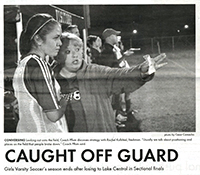
>Ultimately, good photography is about timing and finding the “extraordinary in the ordinary.” Henri Cartier-Bresson believed that every photo has a fleeting “decisive moment” when the photo tells the story best. Consider the photo (click left) from the Munster Crier sports staff. The timing of this image is excellent because readers naturally are interested in what the soccer coach might be saying to freshman Rachel Kalbfeel. The photographer, Cesar Camacho, captures a decisive moment in this soccer game. In effect, Cesar provides the “visual lead” for the story. Because of the strong visual, it makes sense to write a lead that expands on the relationship between Kalbfeel and her coach. To get the details right, I’d suggest showing Kalbfeel the photo and then record her comments about the special moment. That way, the “decisive moment” is not wasted and readers are able to enter the story through the photo, then to a story-telling cutline that feeds the headline(s) and, finally, the lead.
> Here is a sampling of photos from a photojournalist, Jim Richardson, who returned to high school for a photo essay and ended up spending three years at Rossville High School near Topeka, Kansas. Richardson’s beautiful essay became a book titled High School U.S.A. Yes, I realize these photos were taken in 1979. That’s the point. Good photography is timeless. All the more reason to train students how to capture and write about these “decisive moments.” Note not only the photography but the cutline writing as well in Richardson’s work below. Then, imagine the story packages that could flow from these images and moments as described by the subjects themselves.
• Show Me, Don’t Tell Me — It’s a comment straight out of Journalism 101 to say that the best staffs think visually — even (or especially) during the writing process. Descriptive or narrative leads often recreate locations or key moments so the reader can be transported there. Writers “show” their stories when they get out of the way of their sources and allow them space to “talk.” Reporters who paraphrase 90 percent of the story or who rely on the same old sources quoted in the same tired way are “telling” not showing. And readers know the difference.
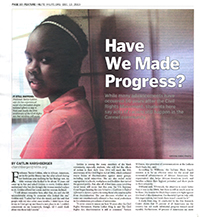 > Anchored by an outstanding photo (CVI), Carmel HiLite editors tackle the difficult subject of race (click left) in a story told through freshman,Tamia Golden. Study the well-crafted narrative lead for this story and note how the headline and cutline helps capture the emotional feel of the story. Then, check out the highly visual “show and tell” on the “jump” page where many sources discuss the progress and difficulties of race relations today.
> Anchored by an outstanding photo (CVI), Carmel HiLite editors tackle the difficult subject of race (click left) in a story told through freshman,Tamia Golden. Study the well-crafted narrative lead for this story and note how the headline and cutline helps capture the emotional feel of the story. Then, check out the highly visual “show and tell” on the “jump” page where many sources discuss the progress and difficulties of race relations today.
> It’s all about photography and text that plays heavily on personal anecdotes and quality quotes in this “show me” piece by the Floyd Central Bagpiper staff.
> The Lawrence Central Cub Reporter staff examines an interesting topic: binge TV watching. Note how reporter Jordan Williams sets up this story with her narrative lead. Also note the number of sources Williams uses to develop this story idea. This is a well-reported multi-source story. Could it have used at least one photo of, say, Sarah Neville watching Breaking Bad? Or an info-graphic breaking down how any hours teens watch TV? Yes on both counts. But I like how Williams uses direct quotes to “show” rather than “tell” this story.
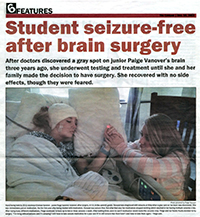
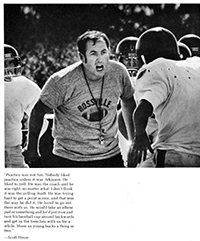


Comments